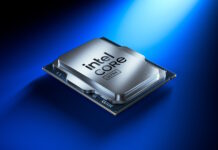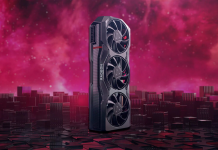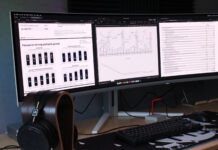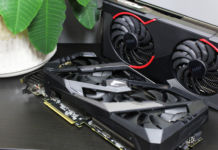We weren’t overly impressed with Gainwards FX 5800 Ultra. A lot of the negative vibes around the product at that time was the immature nature of nVidias drivers. This time nVidia has provided drivers which ensures both higher performance and quality. Of course most of you’ve read the controversial articles on the status of Detonator FX and 3Dmark03 lately, but that’s another story all together.
As we’ve mentioned
here at NordicHardware the flow of videocards into our testlabs have been
strong lately. Last week we posted our preview of the Radeon 9600 Pro. At
that time we didn’t have the main competitor GeForce FX 5600 Ultra but guess
what: today we have just that card.
The manufacturer
is none other than Gainward and we recieved their acclaimed Golden Sample
version which ensures higher clock frequencies. As always Gainward are providing
a high quality package of soft- and hardware. Having a large bundle package
is both positive and negative. Positive since it gives the end user more functionality,
negative since it raises the price and might make the product less competitive
in that point of view. Of course Gainward also supplies resellers with less
extravagant version without all the extras.
We weren’t overly
impressed with Gainwards FX 5800 Ultra. A lot of the negative vibes around
the product at that time was the immature nature of nVidias drivers. This
time nVidia has provided drivers which ensures both higher performance and
quality. Of course most of you’ve read the controversial articles on the status
of Detonator FX and 3Dmark03 lately, but that’s another story all together.
The only thing
that distinguishes the box for this product compared to Gainwards FX 5800
Ultra is the stickers on the front.
Gainward FX PowerPack! Ultra/760 XP Golden Sample

|
Chip: |
NV31 (A1 Stepping)
|
Manufacturing process: |
0.13-micron
|
Transistors: |
~80 mil.
|
Core clock speed: |
350 MHz (380 MHz EM*)
|
Memory clock speed: |
700 MHz (780 MHz EM*) / 10,9 GB/s (12,2 GB/s EM*)
|
Pixel Shader: |
2.0
|
Vertex Shader: |
2.0
|
Pixel
Pipelines/Pixel Fillrate: |
4
/ 1400 MP/s (1520 MP/s EM*)
|
TMU’s/Texel Fillrate: |
1
/ 1400 MT/s (1520 MT/s EM*)
|
RAMDAC: |
(2) 400 MHz
|
Amount of memory: |
128 MB
|
Type of memory and interface: |
128-bit, DDR-SDRAM (Hynix 2,8 ns)
|
In- and outputs: |
VGA, DVI-I, S-Video/Composite In/Out
|
Extra
peripherals: |
Firewire
PCI-card, Firewire cable, ViVo-dongle, DVI-VGA adapter and ATX power
cable extention
|
Software: |
Gainward
Expert Tool, GFX Drivers, WDM Drivers, DirectX 9.0, BIOS Flash Utilities
etc.
|
Full version applications: |
Intervideo
WinCinema (WinDVD 4, WinRip 2 and WinProducer 3 CD)
|
Estimated price: |
~175 USD (Price Watch search)
|
*EM = Enhanced
Mode. Gainwards supports officially sanctioned overclocking through their
Expert Tool utility. This overclocking does not void your warranty and the
product as guaranteed to work properly at the designated clock frequencies.
In fact Gainward recommends using those frequencies when benchmarking and
we certainly don’t see why one shouldn’t use the card in this Enhanced Mode
thus we followed their recommendation.
What gives looking
at the specifics? Well the first thing that struck me with the FX 5600 Ultra
was the fact that it has a lower texel fillrate than the good old GeForce4
Ti4600. The pixel fillrate however is a bit higher. FX 5600 Ultra also has
a bit more bandwidth than Ti4600 but it’s not really nothing worth taking
note of. So the performance gains over nVidias previous series are either
mostly architectural advantages or it’s simply slower than the Ti4600. We’ll
see which it’ll be later on in the review. Gainward has been using their Golden
Sample to promote cards that support the Enhanced Mode mentioned above. (Not
all Golden Samples support this mode though.) We find it funny that Gainward
doesn’t simply ship the card with a BIOS using those clock frequencies.
The transistor count of the 5600 is 80 millions. In comparison Radeon 9600
Pro has roughly 20 millions less transistors which in turn is about as much
as the Radeon 8500 and GeForce4 Ti have.
 Front
Front |
|
 Back
Back |
|
As always Gainward
have that great looking red PCB and red/purple heatsinks. This time the core
heatsink looks like a giant flame, pretty nifty. One thing that I really liked
with this product was the fact that Gainward stopped using thermal pads, instead
they are using high quality thermal paste and the heatsinks are easy to detach
without having annoying sticky "pad-goo" everywhere. A great move
and should be appriciated by all you modders out there.
The long extending fins that makes out the "flames" of the heatsink
doesn’t really do much good or so it seems. While the center of the HSF gets
pretty hot the extending fins don’t seem to transport any heat at all. So
it’s pretty safe to assume that they are mostly there for estethic reasons.
 Input/Output
Input/Output |
|
 Power
Power |
|
One thing that
we missed on Gainwards FX 5800 Ultra was composite and S-Video input. Thankfully
this is back on the FX 5600 Ultra. The supplied dongle offers both in and
output in the form of S-Video and Composite.
One thing that
I had completely missed was the fact that the FX 5600 also uses an external
power source. Apparently the power consumption of this card is too much for
a normal AGP-slot to handle under stable conditions. Pretty strange as it’s
a 350 Mhz part on 0.13 micron process with "only" 128 MBs of 700
MHz DDR. Safety’s first I guess..
Gainward have
a habit of supplying us with multiple in- and outputs and this card is no
exception, thus they’ve bundeled a Firewire card with four ports.
 Input/Output
Input/Output |
The software
package does suffice but it’s nothing amazing in there. DVD software is pretty
much standard with all videocards since a few years back now, Gainward has
been sticking with WinDVD for quite some time. However the Intervideo WinCinema
software package bundeled with the card supplies us with more than that. WinRip
allows you to rip your CDs to MP3 and more. WinProducer 3 CD is an application
for content creation. Burn your captured video to VCD or even "MiniDVD".
This version is, as the title implies, limited to CD-burning thus you can’t
create DVD’s with this one. Both WinRip and WinProducer offers editing functionality
as well.
 Accesories
Accesories |
Gainward has
a pretty impressive bundle of soft- and hardware for their FX 5600 Ultra.
The only thing left to be desired compared to their competitors might be a
game or two. Of course most bundeled games are usually not the best ones out
there. Manufacturers often choose less popular or at least a bit older games
simply because they are cheaper to bundle. All in all we think that Gainwards
package is very nice and thus it deserves a high grade here.
|
Accessories/Features
|
We
look at the amount and usefulness of included accessories and integrated
features. |
|
When it comes
to accessibility we can’t see any problems. A quick search on Price Watch
gave us a lot of it’s and many of them said "in stock". The product
is also affordable at 175 US dollars. This is a dollar or two cheaper than
what you’d have to pay for a Radeon 9500 Pro/9600 Pro. A current generation
mid end card for 175 dollars is surely a good deal in my opinion. (I can tell
you that we’re worse off here in Sweden, right here the cheapest price I’ve
found for this product is an amazing 375 US dollars. That’s simply crazy.
Some of it is due to our extreme VAT, but certainly not all of it.)
|
Price/Accessibility
|
We
compare the price to equal products and also the accessibility among retailers. |
|
There’s a lot
of cards in the benchmarks on the following pages. We’ve tried to cover both
ATi and nVidias current DX9 parts in this price range. As a reference we also
brought in a Ti4600.
|
Test setup
|
|
Hardware
|
| Processor: |
AMD Athlon XP 2600+ (333) Mhz
|
| Mainboard: |
Soltek
SL-75FRN-L
(nForce2)
|
| RAM: |
768 MB DDR333 @ 2-5-2-2 Timings:
2x 256 MB Corsair TWINX512-3200LL DDR-SDRAM
256 MB
PC3200 OCZ PC3200 Rev2 DDR-SDRAM
|
|
Videocards:
|
Gainward GeForce FX 5600 Ultra (128 MB, 380/780)
nVidia GeForce FX 5600 Ultra (128 MB, 350/700)
nVidia GeForce FX 5600 (128 MB, 325/550)
Gainward GeForce4 Ti4600 (128 MB, 300/650)
HIS Radeon 9500 Pro (128 MB, 275/540)
ATi Radeon 9500 (128 MB, 275/540)
ATi Radeon 9600 Pro (128 MB, 400/600)
ATi Radeon 9600 (128 MB, 325/400)
|
|
HDD:
|
80 GB Western Digital Caviar 7200 RPM Special Edition (8 MB cache)
|
|
Soundcard:
|
Creative
Soundblaster Audigy 2 Platinum
|
|
Ethernet:
|
D-Link DFE-530TX 10/100
|
|
Software
|
| Operating system: |
Windows XP Professional (Service Pack 1)
|
| Video drivers: |
nVidia: Detonator FX 44.03
ATi: Catalyst 3.2 6307/Catalyst 3.4 6443
|
| Other drivers: |
nVidia UDA Chipset Drivers v2.03
|
|
Benchmarks:
|
3DMark2001
SE b330
3DMark03 v3.2.0
Quake 3 v1.32
UT2003 v2225
|
Due to the fact
that we’re benchmarking 8 videocards today I had to compromise with the quantity
of tests. Still we feel that the combination of tests chosen should give you
a fair view of the performance of the tested products.
As nVidia now
have fixed their texture filtering IQ we’ve chosen to do all tests with their
Quality setting (which now offers full trilinear filtering). All anisotropic
filtering tests have been been carried out using the Quality settings on both
ATi and nVidia products.
With Detonator FX texture filtering quality is now back to normal like it
looked on the GeForce4 Ti series and is fully comparable to ATi’s Radeon 9500+
product line. FSAA sample patterns are identical with previous driver revisions.
Thus we won’t do any image quality tests in this review as things basically
look as they’ve always looked with nVidias products (except for the first
couple of buggy driver sets since the FX launch that is.)
An unfortunate
fact is that ATi launched their Catalyst 3.4 drivers just a day or two to
late for us. We haven’t noticed much of a change with them though, not even
in the specific cases that ATi specified in the Catalyst 3.4 readme.
When it comes
to Image Quality in general Ultra/760 XP leaves a nice impression. TV-out
and 2D VGA/DVi output has a clear and crisp quality with vibrant colors. In
3D nVidia only has one disadvantage compared to ATi: FSAA modes over 2x.
|
Image
quality
|
|
The
image quality in 2D as well as in 3D are measured. In 3D the quality
of FSAA and Aniso is important. The quality of the TV-out and any other
in and outputs are compared.
|
|
Time for some
good old 3DMarks.
With our Athlon
XP 2600+ we don’t even hit the CPU-limitation fully in Quake 3 and the scores
differ quite a lot. GeForce4 Ti4600 is still going strong in Quake 3 while
9500 and 9600 (non-Pro that is) are almost tied for the last position. The
contender today can’t keep up with it’s older brother. A situation similar
to that of 3DMark2001. Gainwards FX 5600 managed to keep up with the 9500
Pro and the 9600 Pro is left behind once again.
Once we enable
2x FSAA the new FX boards really begin to shine. Gainward are certainly
off to a good start here today. Not even the mid end FSAA demon Radeon 9500
Pro can keep up with nVidias new chip when using 2xAA.
With 4x FSAA
the tables turn to the complete oposite. Now the Radeons dominate. Even
the Radeon 9500 is faster than Gainwards 760 XP.
GeForce FX
5600 handles anisotropic filtering with ease though the 9500 Pro is again
a bit faster.
UT2003 is
one of the more popular games and benchmarks at the moment. It’s some hardcore
DX7 action with a twist of DX8 features when we start benchmarking this
game.
Fillrate is of
the essence when it comes to UT2003 which we can see by the large drop between
1024 and 1600. All cards in our test have problems with running 1600×1200.
Once again
the GainwardFX 5600 pulls ahead once 2x FSAA is enabled…
But this time
it remains highly competitive even with 4xAA. As a matter of fact at 1024×768
it’s faster than the 9500 Pro. At 1600×1200 the preassure becomes too much
but all of the cards are unplayable at this resolution in any case so it
matters less when looking at the big picture.
Anisotropic
filtering and UT2003 with pre-Detonator FX drivers was real nasty. nVidia
has done one amazing job with their optimizations here. FX 5600 is a solid
performer with these new drivers.
As we’ve mentioned
the Gainward Ultra/760 XP GS has the Enhanced Mode overclocking preset which
runs at 380/780 MHz. We’ve also mentioned the fact that there’s a new revision
of the NV31 core that with along with the better heat shield grants a default
speed of 400 MHz. Bringing out a new revision of the chip is a pretty "dangerous"
move. Not for nVidia neccesarily but for the third party manufacturers. Launching
a 50 MHz faster version just weeks after the initial version is kind of "unfair"
to those who bought the first version.
In any case, when it comes to cooling Gainward has made some extra efforts.
The heatsinks are easily detachable and are using a good thermal compound.
We really like this design since it’s now much easier to fit the card with
whatever cooling you find suitable. The fan that looks like a flame does seem
to do it’s job. But the extending "flames" seems to be there simply
to make it look cool as they don’t seem to transport any heat at all. They
do however keep the card cool enough and it’s all easy to remove. We hope
that more manufacturers will follow this trend!
That’s the positive side…
On the negative side of things we find that the fan makes a lot of
noise. In fact it makes more noise than Abits FX 5800 with OTES III for an
example. It’s not just the actual noise level, it’s the pitch or tone of the
noise that’s very irritation. It’s a high frequencie noise, the type that
get’s on your nerves quickly. Making the heatsink larger and the fan slower
would seem like a more sensible idea in my opinion. Perhaps Gainward prioritized
the cool looks of the HSF instead?
 Cooling
Cooling |
An extra plus for the
cool looking and easily detachable cooling, a larger minus for the annoying
sound.
|
Design/Cooling
|
We
takes a look at the functional and aesthetical design. The performance
and sound level of the cooling is also very important. |
|
So enhanced
mode is 380/780, how much room is there left for overclocking beyond that?
Well my initial though was that the core would overclock the most. Alas
this was not the case, at 405 MHz Quake 3 ran fine but 3DMark03 and 2001
kept crashing. For the record 405 MHz was the speed that nVidias auto overclocking
recommended. Obviously a bit flawed, we’ve had the same problem (ie the
Detonators recommending a too high overclock) with all other cards we’ve
tried except Abits FX 5800. When we downclocked the core to 398 MHz 3DMark
was stable again even for multiple loops. Now the memory is where we were
a bit amazed. The Detonators recommended us to overclock it to 790 something
MHz. As the recommended core speed was too high I didn’t think it would
make it but actually the memory had no problems with running even at 836
MHz. Impressive indeed as it is even faster than the default clockspeed
of the FX 5800 non-Ultra.
We had expected
a bit more out of the core overclocking, especially since the above mentioned
second revision of NV31 is on its way. Personally I wonder though if there
will be any overclocking headroom at all in the new revisions. The improved
cooling makes me think that perhaps they’ve "just" pushed the
cores to their limits. All in all it’s not as impressive as the massive
overclocking of 25-35% that we’ve seen on ATi’s Radeon 9500 pro and Radeon
9600 Pro, we expected a little bit more out of nVidias 0.13 micron chip.
The memory overclock was as mentioned a lot better though. So from 350/700
to 380/780 to 398/836, that’s 20 % extra on the memory and nearly 15 % extra
on the core. It’s a pretty standard overclocking results I guess, nothing
too spectacular nothing all too dissapointing either. Let’s see how it effects
performance though, because that’s what really matters here.
Some pretty
nice results here. Overclocking certainly bring a lot of extra value. The
extra bandwidth and fillrate is especially usefull when running with AA/AF.
Since 4x AA was a tad bit slow on the FX 5600 this is certainly performance
that we welcomne with open arms.
While we’re
on the topic of overclocking and enhanced mode I’d like to point out that
others review of Gainwards FX 5600 Ultra have had very different results
from ours. Apparently their card would not overclock nearly as well as the
one we’ve had in our lab. Nor did the Enhanced Mode settings turn out to
be as high as ours and their card was only clocked to 360/720 using Enhanced
Mode unlike ours which was 380/780 MHz. We have no idea on how you can tell
different products apart in this aspect as of yet but Gainward are looking
into it.
|
Overclocking
|
|
Here
we see how much we can overclock the card without suffering from artefacts,
and then measure the performance against the default results.
|
|
We think that
GeForce FX 5600 Ultra is probably the most well rounded product in the FX
series as of yet. It has a great price/performance ratio and remains very
competitive when going up against ATi’s Radeon 9500 Pro/9600 Pro. Gainward
adds value to the board by supplying us with their Enhanced Mode overclocking
and ViVo/Firewire functionality.
My biggest grief
is the noisy cooling actually. I really don’t see why Gainward couldn’t produce
these boards with a more silent solution. The problem doesn’t even seem to
be the temperature here so one can only assume that Gainward went for the
overkill with this high speed fan.
The other problem
here is the fact that the A2 stepping of NV31 sports a 400 Mhz core which
should increase the performance even somewhat over Gainwards Enhanced Mode.
But then again, Gainward are likely to produce boards built on that revision
in a near future too.
Gainward
GeForce FX 5600 Ultra:

|
Pro’s:
+ Firewire card included
+ Solid performance
+ViVo
Con’s:
– Loud
|
Accessories/Features: |
9.0 |
Price/Availability: |
9.0 |
Design/Cooling:
|
|
Image quality:
|
8.5 |
Performance: |
8.5 |
Overclocking: |
8.0 |
Final
Mark : |
8.3
|
Thank you Gainward for making this
review possible!






























